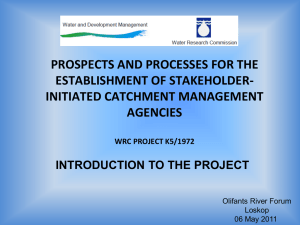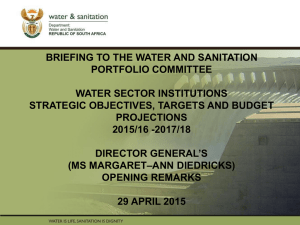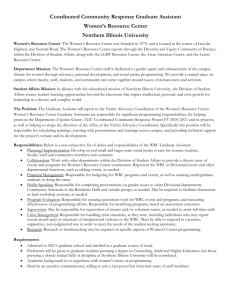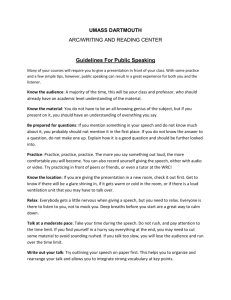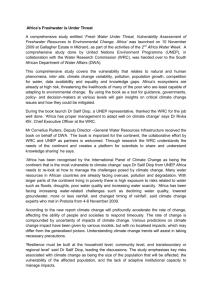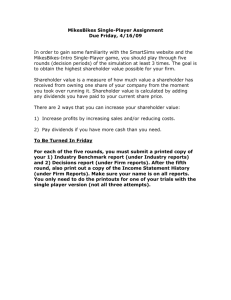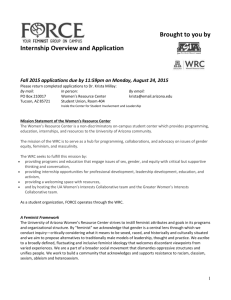WATER RESEARCH COMMISSION (WRC)
advertisement
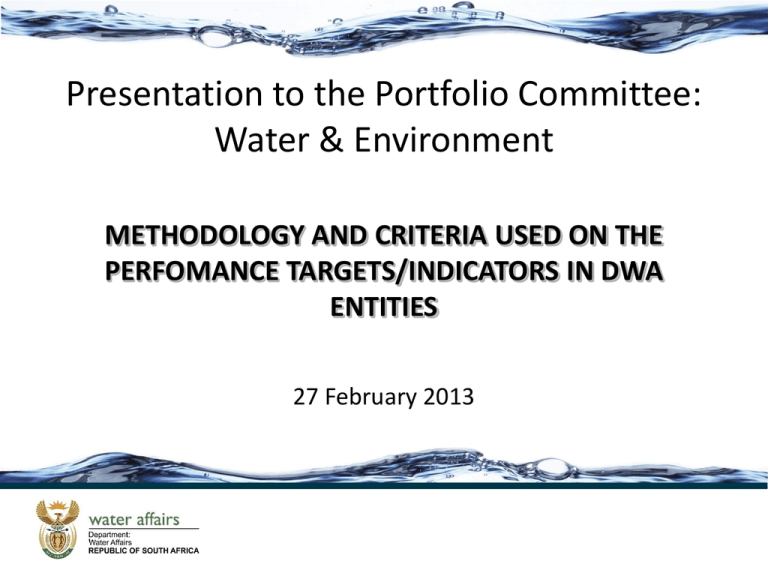
Presentation to the Portfolio Committee: Water & Environment METHODOLOGY AND CRITERIA USED ON THE PERFOMANCE TARGETS/INDICATORS IN DWA ENTITIES 27 February 2013 Policy and legislative mandates • The key government policies pertaining to water are set out in two policy papers as follows: the National White Paper on Water Policy (1997) and The Strategic Framework for Water Services (2003) • The legislative mandates follow from these policies and are set out in three pieces of legislation: The National Water Act (Act 36 of 1998) , The Water Services Act (Act 108 of 1997), The Water Research Act • In terms of the current policy and legislative mandates, it is the Minister who is the custodian , policy maker, and regulator for the water sector. • The Minister is also a shareholder in all DWA entities listed under the Public Finance Management Act. 2 PFMA CLASSIFICATION OF STATE ENTITIES Classification Definition INSTITUTIONS Schedule 2 Major Public Entities (Operates under business principles) TCTA Schedule 3A National Public Entities (Fully or substantially funded through the public funds, tax levy imposed through legislation or water use charges ) Inkomati CMA Breede-Overberg CMA Water Research Commiission Kobwa Schedule 3B National Government Business Enterprises (Operates under business principles with a borrowing limit) 12 Water Boards UNCLASSIFIED WATER USER ASSOCIATIONS & IRRIGRATION BOARDS 179 The borrowing powers is the differentiating factor between the classification The Minister as a Shareholder has distinct responsibilities… Shareholder Responsiblity – Appoint all Board members . – Conclusion of binding shareholder compacts. – Approval of Strategic Plans and Corporate Plans/Annual Performance Plans. – Issuing of a strategic intent statement. – Approval of significant & material transactions. – Recommendations of borrowing limits to National Treasury. – Access information to monitor and evaluate performance. – Enforce accountability and take remedial action. 4 …as distinct from the Board and Management…. Board and Management Responsibility • Responsible for ensuring the financial sustainability of the company through coherent utilisation of company’s assets • Responsibility for development and implementation of the strategy: – Development of strategic and business plans and subsidiary plans. (Financial, risk management, operational, marketing, etc). – Appointment of management and staff. – Management of all aspect of operations. – Development of detailed company policies (e.g. remuneration, procurement, etc) within guidelines defined by practice notes and implementation of company practice in adherence to the policy. 5 Relationships between institutions and DWA Parliament Portfolio Committee reviews reports and plans (hearings, visits) (1) Oversee institutional establishment; (2) Oversee governance (manage board appointment processes, training etc.); (3) Oversee shareholder compact; (4) Oversee business plans, quarterly performance reports and financial statements etc. Minister DWA Minister appoints boards; approves shareholder compacts, Corporate Plans & Annual Reports Public institutions report to the public and Parliament through Annual Reports and Annual Financial Statements and to the Department with quarterly performance reports TCTA CMA 1 CMA 2 Water board 1 WB 2 WB 12 WRC OVERVIEW of WATER BOARDS THEY DERIVE THEIR MANDATE FROM THE WATER SERVICES ACT, 1997 AND ARE LISTED AS SCHEDULE 3B UNDER THE PFMA , 1999. 7 Oversight role over WBs List of Documents submitted to the Minister Legislation Policy Statements Sec 39 of Water Services Act, 1997 Shareholder Compacts Treasury Regulation 29.2 Corporate Plan & projection of revenue, expenditure & borrowings Sec 52 of PFMA, 1999 Treasury Regulation 29.1 Business Plans Sec 40 of Water Services Act, 1997 Quarterly Reports Treasury Regulation 29.3.1 Annual Reports Sec 44 of Water Services Act, 1997 Sec 55(1)(d) & 65 of PFMA, 1999 Tariff Increases Sec 42 of MFMA, 2003 Financial misconduct procedures report Treasury Regulation 33.3.1 Materiality & Significance Framework Treasury Regulation 28.3.1 8 Minister is the sole shareholder The shareholder management process • Minister meets with Chairpersons of entities to outline the Strategic Intent which is used to articulate her vision and her expectations of the entities. Strategic Intent • The DWA Strategic Plan is a guide to entities in terms of vision and strategic direction. Statement/ DWA Strategic Plan Shareholder Compact • Minister and The Boards conclude a shareholder compact annually (Treasury Regulation 29.2) . • Documents the mandated key performance measures and indicators to be attained by the entity in delivering the desired outcomes and objectives as agreed between the entity Board and the Minister. • Entities submit corporate plans and budgets annually to Minister and National Treasury at least one month before the start of financial year (PFMA Sec 52). • Entities corporate plan must contain implementation details to attain the key performance measures and indicators outlined in shareholder compact and desired outcomes and objectives outlined in the strategic intent Corporate Plan statement. Performance Monitoring & Evaluation Quarterly reporting Annual Reports including financial statements submitted by end of November every year. Tariff Submissions to Parliament by 15 March every year. Reporting to Portfolio Committee –once a year . 9 Selected Objectives & Indicators for Water Boards Performance Objective Alignment Ministerial Outcomes DWA Strategic Plan Outcomes /Impact Indicators Measure 1. Water MO A, OP1, Ta) & c). MO B, OP2, Ta) SO 2.5 & 3.4 Water quality standards met Test results, SANS 241 % compliance 2.Non Revenue Water MO A, OP1, T a) MO B,OP2, T a) SO2.2, 2.5, 2.6,&2.7 Reduced levels of unaccounted for water (UAW) Water lost as a % of total water produced % 3. Reliability of supply MO A > G OP1, Ta), b) & c). OP2, Ta) So1.1, 1.2&1.3 No unplanned interruptions to supply exceeding 24 hours % number of days supply disrupted divided by total number of possible supply days % 4. Financial Reporting Compliance MO A > G SO 6.5 & 6.6 unqualified audit report Annual external audit Qualified/ Unqualified 13. Increased Access to Services MO A, B &D OP1, Ta), b) & c). OP2, Ta) SO 1.1,1.2, 1.3,2.2 and 4.1 Contribution to national objectives CAPEX spend /projects CAPEX spend or number of expansion projects Quality Compliance 10 Rationale and criteria for selecting indicators • Ensure that entities are aligned to government objectives to support and drive development in key sectors. • Mobilisation of additional financial resources required to support developmental strategy. • Roll out of key infrastructure to enable economic and social development • Indicators to support building a solid institution –run on business principles -financial viability and good governance. 12 13 14 Risk Management Process 1. Objective setting (what is our mandate, objectives, etc) 2. Risk identification (what can go wrong, what can prevent objectives being achieved, causes of risk?) 3. Risk analysis (what are the chances of the risk occurring [LIKELIHOOD], what will be the effect when it occurs (IMPACT]). 4. Risk response (avoid, accept, reduce or share the risk by developing controls, procedures, etc to reduce risk to acceptable levels). 5. Control activities (policies and procedures are established and implemented to ensure the risk responses are effectively carried out). 6. Information and communication (information is captured and communicated so that people are able to carry out their risk management duties). 7. Monitoring (ongoing management activities and separate evaluations). 15 OVERVIEW OF OTHER ENTITIES 16 Trans-Caledon Tunnel Authority (TCTA) • Established in 1986 in terms of the National Water Act, is categorized as a Schedule 2 major public entity and is subject to the PFMA. • TCTA is engaged in project financing and implementation together with being a specialized liability management entity. It finance and implements bulk raw water infrastructure in a cost effective manner to benefit water consumers. • Projects under management by the TCTA: – Lesotho Highlands Water Project – Debt under management is R16.8 billion, paid for from revenue generated from water sales. Loan raised on explicit government guarantees. – Berg Water Project – Debt under management is R1,6 billion, paid for from revenue generated from water sales, and loan raised by implied government guarantees. 17 Trans-Caledon Tunnel Authority (TCTA) – Vaal River Eastern System Augmentation Project – Debt under management is R2,7 billion, paid for from revenue generated from water sales, and loan raised by implied government guarantees. • Four new mandates have been issued to the TCTA including the Olifants River Water Resources Development Project Phase 2, the Komati Water Scheme Augmentation Project, the Mooi-Mgeni Transfer Scheme, the Mokolo-Crocodile Water Augmentation Project, Metsi Bophelo Borehole Project and Acid Mine Drainage. 18 Trans-Caledon Tunnel Authority (TCTA) 19 Water Research Commission (WRC) • Established in terms of the Water Research Act, 1971 • Plays an important role in water research by establishing needs and priorities for research, stimulating and funding water research according to priority, promoting effective transfer of information and technology and enhancing the knowledge and capacity of the water sector. • Key research areas includes: – Water resource management – Water linked ecosystems – Water use and waste management – Water utilization in agriculture • WRC mainly derives its income from a levy on raw water tariffs which is currently 4.60 cents a cubic meter for domestic use. It also obtains leverage income. 20 WATER RESEARCH COMMISSION (WRC) The process conducted to develop the Corporate Plan was characterised by three important elements. • Firstly, it has been an on-going and iterative process. • Secondly, it has been consultative, incorporating discussions and considerations from DWA and WRC stakeholders in various forums. • Thirdly, it has employed both a forecasting and back-casting approaches to the development of strategic objectives, involving an analysis of the WRC’s current positioning in the sector as well as a reflection on developments and potential developments in the external and organisational environment that could have an impact on the five-year planning cycle. All of this been has been under the guidance of the WRC Board. WATER RESEARCH COMMISSION (WRC) cont. • The formal planning process commenced in May 2012 with a corporate planning workshop that included the operationalization of the WRC Knowledge Tree as well as the following elements: • Business management process analysis. • The internationalisation of the WRC and its implications. • A focus on improving the WRC’s impact with a focus on bottom of the pyramid (BOP) interventions, coupled with closing the innovation chasm. • The introduction of the WRC Lighthouses in the five-year plan. These are key flagship projects or programmes that would become trailblazers for the WRC and its stakeholders, both internally and externally. WATER RESEARCH COMMISSION (WRC) cont. • exercise which should inform the WRC’s core business. • The top four Lighthouses proposed include: • the green village concept; • water governance; • water-sensitive urban design with a focus on wastewater; • the water-energy-nutrition/food nexus. • Climate change interventions • . Water Research Commission (WRC) WRC reports progress against its key performance areas in terms of new projects, finalised projects and new innovations as follows: • Knowledge generation • Knowledge dissemination – – – – Workshops Issues of Water Wheel Technical and policy briefs Issues of Water SA • Capacity building (number of students) • Expansion of the Fund Management System (including short term research projects) 24 OVERVIEW of Catchment Management Agencies 25 Enabling legislation • • • • Catchment Management Agencies (CMAs) are established in terms the National Water Act, Act 36 of 108 of 1998 (Chapter 7) CMAs are subject to the Public Finance Management Act (PFMA) and related Treasury regulations– categorized as a Schedule 3A entity: “service delivery public entity” The purpose of the CMA is to delegate water resource management to the catchment level and to involve local communities in the decision-making processes. Broadly, the initial role of a CMA is articulated in the Act as: • • managing water resources in a WMA, co-ordinating the functions of other institutions involved in water related matters and involving local communities in water resource management 26 DWA’s OVERSIGHT ROLE OVER CMAs Compliance monitoring List of Documents submitted to the Minister Legislation Annual Report & Audited Financial Statements PFMA: Sec 55 (d) Business Plans TR 30.1.1 and Schedule 4 of the National Water Act, 1998 Budget of estimated revenue & expenditure for the year PFMA: Sec 53(1) Quarterly Reports on actual revenue & expenditure for the quarter & projection of expected expenditure & revenue for remainder of financial year TR 26.1 TR 30.2.1 Financial misconduct procedures report TR 33.3.1 27 Dwa’s oversight responsibilities • Schedule 4 Part 4: • Institutional planning outlines the responsibilities of the CMA GB and staff, particularly in terms of the CMA Business Plan, General matters to be included in business plans, which is the main tool for formal oversight, including: – – – – – – Organisational / institutional matters Governance Functions Financial (PFMA) requirements Transformation and HR EE policy, etc (organ of state and must comply) • Schedule 4 Part 5 outlines the monitoring and intervention by the Minister • Schedule 4 Part 6 outlines records and reports • The catchment management strategy provides the mechanism to influence the vision, priorities and direction that the CMA takes. • The catchment management strategy is most important instrument for the integrated management of water resources in a Water Management Area as well as an oversight tool for DWA to audit the CMA 28 Selected Objectives & Indicators for CMAS Performance Objective Alignment Ministerial Outcomes DWA Strategic Plan Outcomes /Impact Indicators Measure Validation and Verification of water use MO A, OP1, Ta) & c). MO B, OP2, Ta) SO 2.5 & 3.4 Updated and completed registrations Number of validations and verifications completed Water quality monitoring MO A, OP1, Ta) & c). MO B, OP2, Ta) SO 2.5 & 3.4 Enhance and maintain water quality Test results, SANS 241 Water Resource pollution prevention MO A, OP1, T a) MO B,OP2, T a) MO A > G OP1, Ta), b) & c). OP2, Ta) SO2.2, 2.5, 2.6,&2.7 Good water quality Number of interventions over incidents number So1.1, 1.2&1.3 WUAs established /transformed Number established Number MO A > G SO 6.5 & 6.6 Establishment/transformat ion of WUAs Number % compliance Number transformed 29 END 30
